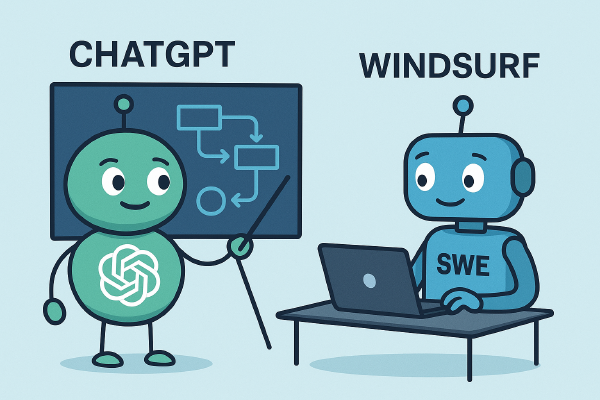
🚀 The Future of Software Development is Here
In recent years, AI has evolved from a coding assistant to a full-stack developer. This series demonstrates how to leverage ChatGPT (GPT-4o with Deep Research) to instruct Windsurf IDE (SWE-1 model) in building a complete, production-ready application—without writing a single line of code yourself.
“The most profound technologies are those that disappear. They weave themselves into the fabric of everyday life until they are indistinguishable from it.” — Mark Weiser
📚 What We’ll Be Building: Splitwisely
I decided to build Splitwisely, an expense-sharing application similar to Splitwise that helps friends and roommates track and settle shared expenses. I chose this project because it covers many aspects of modern app development:
- User authentication and management
- Group creation and management
- Expense tracking and splitting
- Real-time balance calculations
- Clean, responsive UI
🛠️ Series Overview
Part 1: Setting Up ChatGPT to ask right questions
- Crafting optimized prompts for Windsurf IDE
- Establishing clear project intentions
- Creating an effective AI workflow
Part 2: Mastering AI-to-AI Communication
- Techniques for refining prompts
- Best practices for AI collaboration
- Ensuring clarity in AI instructions
Part 3: Defining Project Requirements
- Using AI to ask the right questions
- Creating comprehensive project specifications
- Validating requirements before implementation
Part 4: Configuring Windsurf IDE
- Setting up development environments
- Establishing coding standards
- Creating reusable templates
Part 5: From Idea to Implementation
- Generating Product Requirements Documents (PRD)
- Breaking down features into tasks
- Creating actionable development plans
Part 6: AI-Powered Development
- Implementing features with AI assistance
- Code review and iteration
- Testing and quality assurance
Part 7: Documentation and Maintenance
- Automated documentation generation
- Keeping documentation in sync
- Long-term maintenance strategies
🔍 Why This Matters
The traditional software development lifecycle is being transformed by AI. This series demonstrates how:
- Productivity - Reduce development time from weeks to days
- Accessibility - Enable non-coders to build complex applications
- Quality - Leverage AI’s ability to follow best practices
- Innovation - Focus on what matters while AI handles implementation
🎯 Who Should Follow This Series
- Developers looking to enhance their workflow with AI
- Product Managers wanting to prototype ideas quickly
- Startup Founders with limited technical resources
- AI Enthusiasts curious about practical applications
🚀 What’s Next?
In Part 1, we’ll dive into setting up ChatGPT to effectively communicate with Windsurf IDE. You’ll learn how to craft prompts that produce high-quality, production-ready code.
Ready to see the future of software development? Let’s begin!
References
The Ninja Studio. (2025). AI-Assisted Software Development in 2025. https://www.theninjastudio.com/blog/ai-assisted-software-development
DevOps.com. (2025). Windsurf Launches SWE-1: AI Models Built for the Entire Software Engineering Process. https://devops.com/windsurf-launches-swe-1-ai-models-built-for-the-entire-software-engineering-process/
comments powered by Disqus
